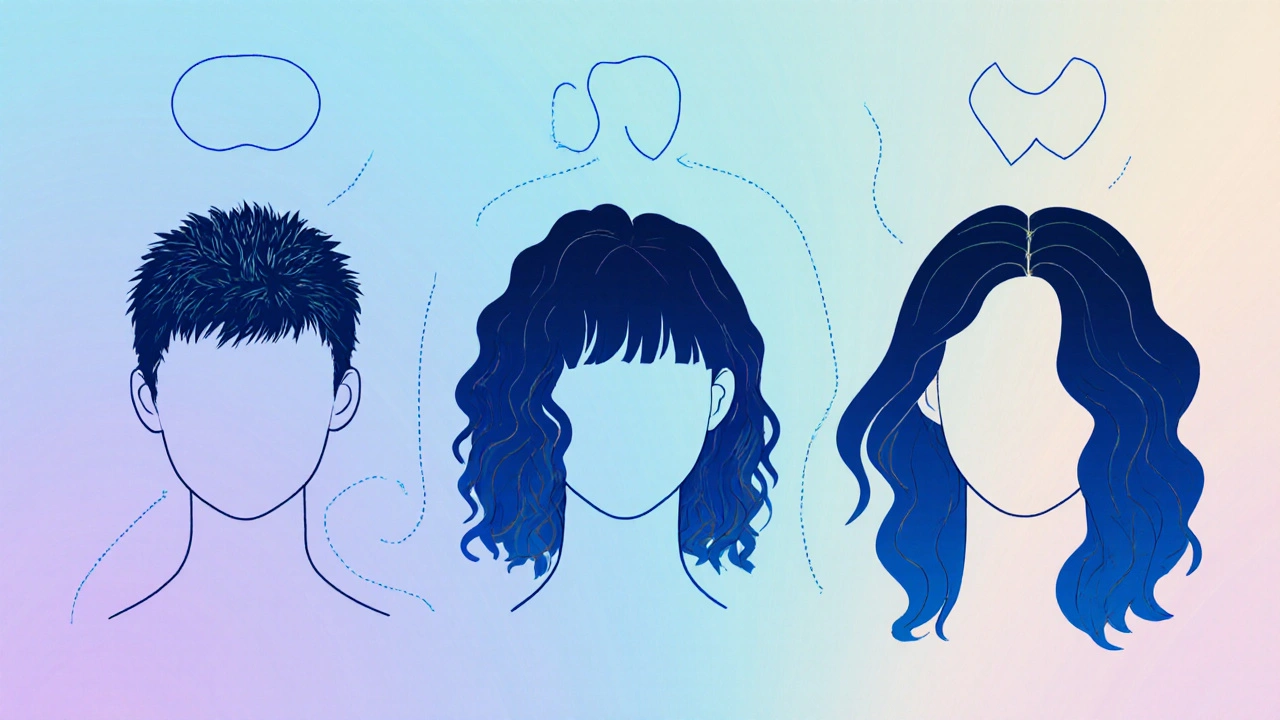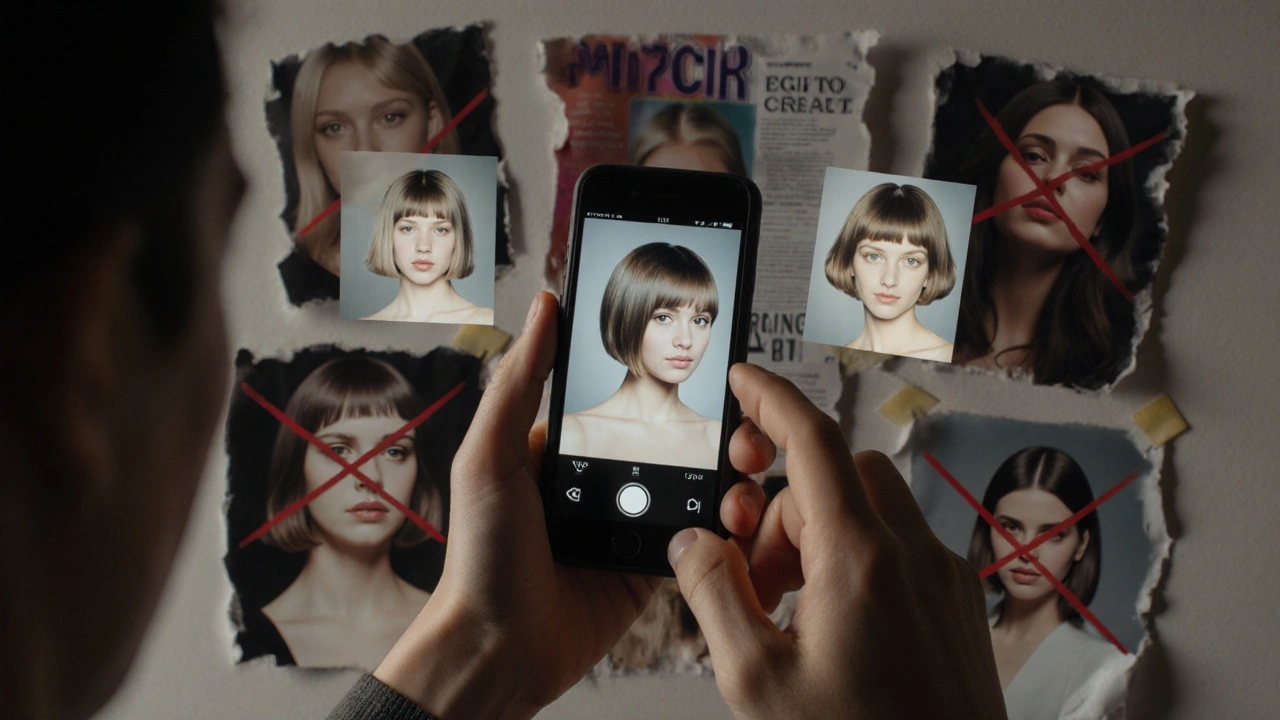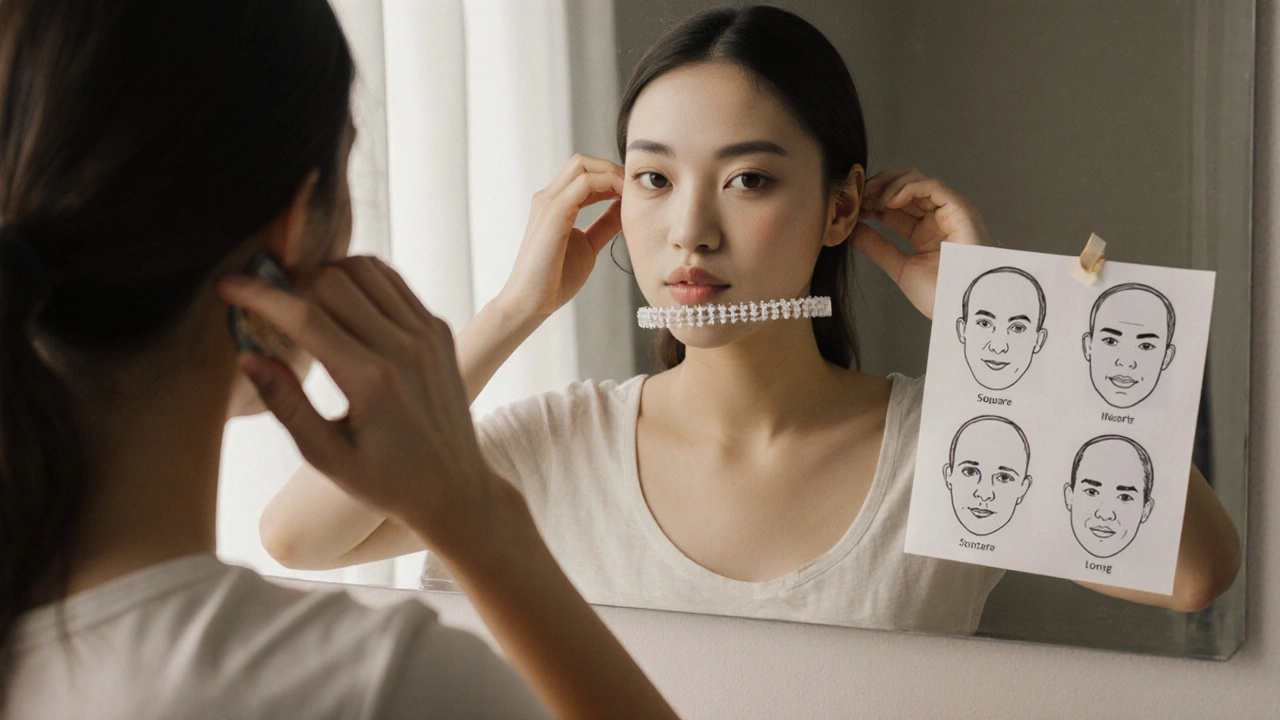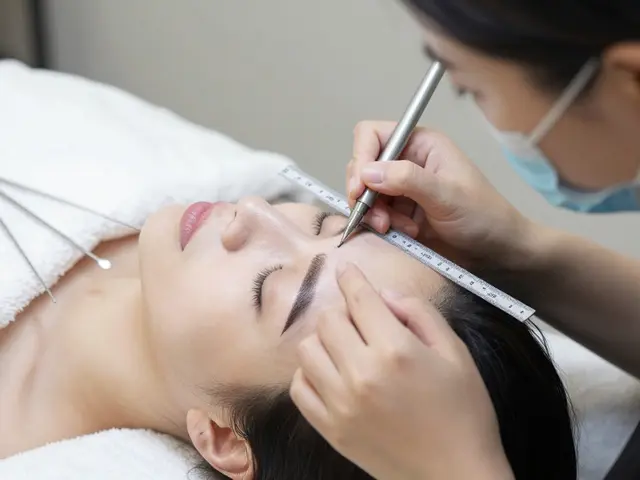Choosing a haircut isn’t just about what’s trending on Instagram. It’s about what actually works for your face, your hair texture, your daily routine, and even your job. A bad haircut can make you feel off for months. A good one? It can boost your confidence without a single product. So how do you pick one that sticks?
Start with your face shape
Your face shape is the foundation of every great haircut. Skip this step, and you risk picking a style that doesn’t flatter you - no matter how many celebrities rock it.
Look in the mirror. Pull your hair back. Trace the outline of your face with your finger. Here’s what to look for:
- Oval: Forehead slightly wider than jaw, cheeks the fullest part. Most haircuts work here. You’re the baseline.
- Round: Cheeks and jawline are about the same width. Length is key. Avoid blunt bangs or cuts that end at the chin - they make your face look wider.
- Square: Strong jaw, broad forehead. Soften the angles with layers, side-swept bangs, or longer styles that add curve.
- Heart: Wider forehead, narrow chin. Balance with volume at the jawline. Pixies with side-swept bangs or long layers work well.
- Long (oblong): Face is longer than it is wide. Add width with bangs, layers around the cheeks, or side-parted styles. Avoid super long, straight cuts - they exaggerate length.
Don’t overthink it. Take a photo of your bare face from the front and side. Print it out. Circle the shape. Now you’ve got a visual guide.
Consider your hair texture
Two people can have the same face shape, but one has thick, curly hair - the other, fine, straight hair. They need totally different cuts.
Ask yourself:
- Is your hair fine? Avoid heavy layers or blunt cuts that weigh it down. Short bobs, textured pixies, or soft layers add volume.
- Is it thick? You need structure. A blunt bob, a shag, or a layered mid-length cut helps control bulk. Don’t go too short unless you want to lose control of the volume.
- Is it curly or wavy? Never cut curly hair dry. It shrinks up to 50% when it dries. Ask your stylist to cut it wet but styled - so they see how it naturally falls. Avoid blunt ends; they look frizzy. Layers that follow your curl pattern are key.
- Is it straight? You can pull off sharp lines, blunt bobs, or long layers. But if it’s super fine, skip heavy bangs - they’ll flatten.
Pro tip: If your hair is curly, don’t copy a straight-haired influencer’s cut. You’ll end up with a frizzy mess. Look for people with your exact curl type - Type 2A, 3B, etc. - and see what works for them.
Think about your lifestyle
Do you have 5 minutes in the morning? Or do you enjoy spending 20 minutes styling your hair like a ritual?
Here’s the reality check:
- Busy parent? Athlete? Nurse on 12-hour shifts? Keep it short or shoulder-length. A pixie, bob, or lob (long bob) with minimal styling is your friend. Avoid anything that needs heat tools daily.
- Office job with a dress code? Avoid extreme colors or styles that look unprofessional. A clean, classic cut with subtle layers works. Think: textured bob, side-parted waves, or a soft fringe.
- Artistic job or freelance? Go wilder. As long as it’s well-maintained, bold cuts like asymmetrical bobs, undercut fades, or color pops are fair game.
Ask yourself: Will I still like this in 3 months? Will I hate washing it every day? Will I need to buy five new products to make it work? If the answer is yes to any of those, reconsider.

Test before you cut
There’s a reason salons offer virtual try-ons now. You can’t undo a haircut.
Try this:
- Take a photo of yourself with your current hair.
- Use a free app like YouCam Makeup, Hair Try-On by L’Oréal, or even TikTok’s filter library to simulate different cuts.
- Hold a ruler up to your face. Measure from your ear to your jawline. If it’s less than 2 inches, a chin-length bob might suit you. If it’s more than 3 inches, longer styles will balance your proportions.
- Wear a headband or clip a section of your hair up. See how it changes your face. Does it open up your eyes? Make your jaw look stronger?
Don’t trust your gut alone. Use tools. Take screenshots. Show them to your stylist.
Bring visuals to your stylist
Saying “I want something cute” won’t help. Stylists hear that every day.
Instead, bring:
- At least 3 photos - one of a cut you love, one you hate, and one that’s close to your hair type.
- Photos that match your face shape and texture. Don’t bring a photo of a celebrity with thick, curly hair if yours is fine and straight.
- Write down what you like: “I like the volume at the top,” or “I don’t want anything that needs blow-drying.”
Good stylists will tell you if a cut won’t work for your hair. Don’t be offended. They’ve seen it all. If they say, “That won’t hold on your texture,” listen.
Don’t ignore maintenance
Some cuts look amazing on day one - and fall apart after 3 weeks.
Ask yourself:
- How often do I want to go back? (Every 4 weeks? 8 weeks?)
- Do I need to use a specific product every day? (Mousse? Pomade? Curl cream?)
- Can I style it myself, or do I need a professional every time?
For example: A textured undercut looks sharp - but if your hair grows fast, you’ll need a trim every 3 weeks. A long shag? You can go 8 weeks between cuts if you use dry shampoo and a round brush.
Be honest about your willingness to maintain. A high-maintenance cut you can’t keep up with becomes a source of stress, not confidence.

What to avoid
Here are the top 3 mistakes people make:
- Copying a celebrity cut without checking their hair type. Emma Stone’s blunt bob looks great on her thick hair - but on fine hair, it just looks flat.
- Going too short too fast. If you’ve never had short hair, start with a lob. Then go shorter next time.
- Ignoring your natural part. If your hair naturally parts on the left, don’t force a center part. It’ll look awkward and take weeks to train.
Also, avoid cuts that require heat tools daily unless you’re okay with potential damage. Heat = dryness = breakage. If you’re not willing to use heat protectants and deep conditioners weekly, skip the blowout styles.
When to wait
Some people rush into a big change after a breakup, a job loss, or a move. That’s fine - but don’t let emotion drive your scissors.
Wait a week. Take a walk. Look in the mirror again. Ask a trusted friend: “Does this look like me, or like the version of me I wish I was?”
Great haircuts don’t just change your look - they reflect who you are right now. Not who you want to be.
Final checklist
Before you sit in the chair, run through this:
- ✅ I know my face shape.
- ✅ I know my hair texture and how it behaves when wet/dry.
- ✅ I’ve considered how much time I’ll spend styling it daily.
- ✅ I’ve brought 3 clear photos - one I love, one I hate, one similar to my hair.
- ✅ I’ve asked my stylist what they’d change about my chosen cut for my hair type.
- ✅ I’ve thought about how often I can realistically get trims.
If you checked all six, you’re ready. And you’re way ahead of most people walking into a salon.
How do I know if a haircut will suit my face shape?
Take a photo of your bare face from the front and side. Trace the outline - is it round, square, oval, heart-shaped, or long? Then match it to the standard guidelines: oval faces suit most styles, round faces need length, square faces benefit from soft layers, heart shapes need volume at the jaw, and long faces need width. Apps like YouCam Makeup can simulate cuts before you commit.
Can I get the same haircut as my favorite celebrity?
Only if your hair type and face shape match theirs. A pixie cut looks stunning on Zendaya because she has fine, straight hair and an oval face. If you have thick curls and a round face, that same cut will look completely different - and likely not as flattering. Always match the cut to your own features, not just the celebrity.
How often should I get a trim after a new haircut?
It depends on the style. Short cuts like pixies or bobs need trimming every 4 to 6 weeks to keep shape. Medium cuts like lobs or shags can go 6 to 8 weeks. Long hair can stretch to 10 to 12 weeks if you’re just trimming split ends. But if your cut relies on layers or texture, don’t wait longer than 8 weeks - the shape will start to fall apart.
Is it okay to change my haircut during winter?
Absolutely. Winter doesn’t restrict your options - but it does change how you maintain them. Short cuts can feel colder, so consider adding a bit of length around the ears if you’re sensitive to cold. Curly hair tends to get drier in winter, so avoid cuts that expose too much of the ends. Focus on hydration and protective styles, not just looks.
What if I hate my new haircut after a week?
Don’t panic. Most people adjust in 2 to 3 weeks. Hair grows about half an inch per month, so even a drastic cut will soften quickly. If you still hate it after 4 weeks, go back to your stylist. Most salons offer a free fix within 2 weeks, and many will help even after that if you’re honest. Never try to cut it yourself - you’ll make it worse.







Sandy Dog
November 17, 2025 AT 00:32OMG I JUST GOT A PIXIE CUT AFTER READING THIS AND NOW I LOOK LIKE A 1998 BRITNEY SPEARS MUSIC VIDEO 🤪😂 I thought I had an oval face but turns out I’m a round face with a personality disorder 😭 My stylist said ‘you’re brave’ and I cried in the chair-then bought three hats and a headband. Worth it? Maybe. Do I regret it? Not even a little. Send help. Or glitter.
Nick Rios
November 18, 2025 AT 20:49This is actually one of the most thoughtful guides I’ve read on haircuts. I used to just point at a celebrity photo and say ‘like that’-ended up with a choppy mess that took six months to grow out. The part about face shape and texture being separate factors? Game changer. I’m going back to my stylist with photos this time. No more guessing.
Amanda Harkins
November 19, 2025 AT 09:52You know, I think haircuts are just mirrors for our internal chaos. We don’t cut our hair because we want to look good-we cut it because we’re trying to become someone else for a little while. The blunt bob? That’s the ‘I’m done with my ex’ haircut. The long shag? That’s the ‘I’m rebranding my soul’ haircut. And the pixie? Oh honey, that’s the ‘I’m not sorry for anything’ haircut. We don’t choose haircuts. Haircuts choose us.
Jeanie Watson
November 20, 2025 AT 05:34Yeah I read it. Cool. I just got a trim. Done.
Tom Mikota
November 21, 2025 AT 00:13‘Avoid blunt bangs’-wait, did you mean ‘blunt’ as in ‘not angled’ or ‘blunt’ as in ‘a tool used for cutting’? Because technically, all bangs are blunt unless they’re feathered, right? And ‘lob’? That’s not even a word. It’s a lazy abbreviation. Also, you say ‘curl type 3B’ like it’s a scientific classification-when did the American Hair Society start issuing degrees? This article is a mess. But… kinda useful? I guess.
Mark Tipton
November 21, 2025 AT 19:41Let me ask you this: What if the entire face-shape classification system is a capitalist construct designed to sell haircuts? Who decided oval faces are ‘ideal’? Was it Vogue? The Roman Empire? The Illuminati? And why do we assume hair texture is biological when it’s clearly influenced by water hardness, silicone buildup, and the emotional trauma of our mothers’ perms in the ‘90s? Also-have you considered that the ‘you can’t undo a haircut’ narrative is fear-mongering? Hair grows back. We are not trees. We are not statues. We are evolving organisms with scalp follicles that respond to lunar cycles. I’ve cut my own hair with kitchen scissors for 12 years. I’m 47. I look like a Renaissance painting. And I’ve never paid $80 for a ‘consultation’.
Adithya M
November 23, 2025 AT 10:31Bro this is so accurate. I’m from India, curly hair, round face, and I kept trying to copy Keanu Reeves’ cut-ended up looking like a confused poodle. After following the texture + face shape combo, my stylist gave me a layered shag with side-swept fringe. Now I get stopped on the street. Not for being hot-because I’m not-but because people think I’m a Bollywood actor. Thank you. 🙏
Jessica McGirt
November 24, 2025 AT 00:14I appreciate how this guide emphasizes self-awareness over trends. Too many people chase aesthetics without considering practicality. I’m a nurse who works 12-hour shifts-I used to spend 30 minutes styling my hair every morning. After switching to a chin-length bob with micro-layers, I save 20 minutes daily. That’s 140 minutes a week. That’s 7,280 minutes a year. That’s over 120 hours. I’ve read 15 books since I got this cut. Haircuts aren’t vanity-they’re time management.
Donald Sullivan
November 24, 2025 AT 01:14Y’all are overthinking this. I got a buzz cut last week because I was tired of washing my hair. Now I don’t care about face shapes or curl patterns. I just rinse and go. If you’re spending this much energy on your hair, maybe you should get a hobby. Or a therapist. Or both.
Tina van Schelt
November 25, 2025 AT 14:51I went from ‘mousy brown mullet’ to ‘coppery lava flow with face-framing layers’-and I swear, it didn’t just change my look, it changed how people treated me. Strangers held doors. Cashiers smiled. My dog stopped ignoring me. I didn’t change my personality-I just changed the frame. Hair is armor, people. Wear it like you mean it.
Ronak Khandelwal
November 25, 2025 AT 21:24❤️ This made me cry a little. I’m a single mom of three, and I haven’t had a haircut I truly loved since 2018. I used to feel invisible. But I followed your checklist-took photos, showed my stylist, asked for a lob with texture-and now when my kids say ‘Mommy, you look like a movie star,’ I believe them. You don’t need to be perfect. You just need to be seen. And your hair? It can be the first thing that says, ‘I see me too.’ 🌸
Jeff Napier
November 27, 2025 AT 17:26Face shapes are a myth. You’re all being manipulated by Photoshop algorithms and salons that profit from insecurity. Your face is a unique constellation of bone and fat and trauma. No ‘oval’ exists. No ‘round’ exists. There’s only you-and the lies you’ve been sold to make you buy products. Also, why are you all using apps? Just stare into a mirror. The truth is in the silence. And your hair? It’s just dead cells. Let it grow. Let it fall. Let it be.
Sibusiso Ernest Masilela
November 28, 2025 AT 09:57How quaint. You all treat haircuts like a psychological journey. Meanwhile, in real life-where men wear their hair short and women wear theirs long because that’s what civilization has dictated for millennia-you’re overanalyzing a 2-inch difference in length like it’s a Nobel Prize in aesthetics. If you want to look ‘professional,’ keep it neat. If you want to look ‘artistic,’ go wild. But don’t pretend your bob is a metaphor for your soul. It’s hair. It’s not therapy. It’s not a manifesto. It’s not a revolution. It’s a haircut. And if you can’t afford a good stylist? Just grow it out. Or shave it. Either way, stop making it so complicated.